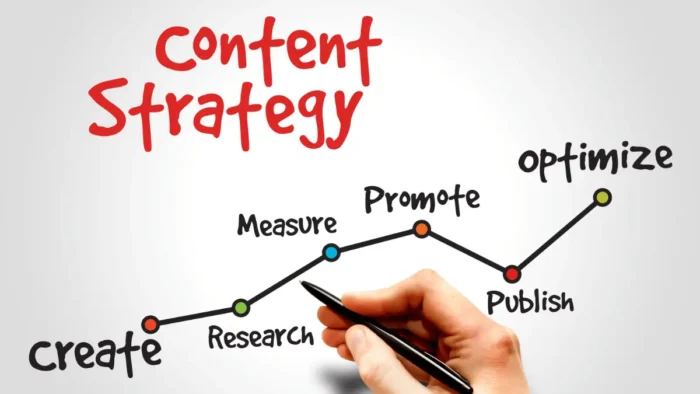Crafting an effective content marketing strategy is a must for every business today.
Content marketing involves creating actionable content and distributing it through selected online channels. It goes beyond the usual route of brand promotion and aims to stimulate interest among readers or content consumers.
This detailed guide will explain a simple yet comprehensive nine-step process for successfully creating, deploying, and evolving your content marketing strategy.
Effective and influential content will always attract and maintain customers because it provides them with engaging and valuable materials to learn about and relate to your brand.
Along this line, content marketing enables your business to sustain customer loyalty, generate online sales, increase awareness and credibility, and build a community of engaging and responsive customers.
However, the process doesn’t need to be hard despite content marketing being an extremely competitive arena.
📖 Key Takeaways
- Content marketing is still relevant, important, and beneficial for companies regardless of size because it allows them to generate qualified leads and build stronger customer relationships.
- You can conduct a nine-step approach to create a content marketing strategy. Use the content marketing strategy template in Excel that I will share in this article and start building your content strategy.
- Remember that the content strategy is about creating content and distributing, organizing, and performance measuring to improve your content strategy as you go.
Is Content Marketing Still Relevant?

The short answer is yes, absolutely. Content marketing is more relevant than ever in today’s digital world. In fact, 90% of marketers include content in their marketing strategies, demonstrating that content marketing is becoming an indispensable part of comprehensive marketing approaches. It has become essential to any successful digital marketing strategy for small businesses.
Here are a few reasons why content marketing continues to be highly effective:
Builds higher level of trust and relationships
People usually purchase from those they really trust and relate to.
If you continuously produce valuable and relevant content for your audience, you can establish yourself as an authority in your industry and build trust with customers.
More organic traffic to your website
With the right SEO strategies, your content can rank high on search engines, bringing increased organic traffic to your website.
This means more customers will find your business without you having to pay for ads or promotions.
Content marketing will generate qualified leads.
Content tailored to your target audience’s interests and pain points can attract qualified leads who are more likely to convert into paying customers.
What’s your natural reaction when you’re bombarded with ads? If you’re like most people, you probably want to run and hide or yell back at the advertisers. It all depends on your personality.
After all, who doesn’t get annoyed by the 5th or 6th consecutive TV commercial when all you want to do is watch what you tuned in for?
The Content Marketing Premise
Many of us approach content marketing in the wrong way. We usually research keywords and niches while eventually just creating content, a mediocre piece that isn’t even well-promoted.
Moreover, it is important to realize that overcomplicating the content creation process isn’t something I would advise. In most cases, the best content isn’t necessarily considered as successful as creation depends on host factors, which are often ignored, to be the early bird.
All speculations, judgments, and validations aside, content marketing has to be presented and approached in a more simplified manner to pay dividends.
Content Marketing Strategy VS Social Media Strategy
While the two may seem similar, they have a key difference. A content marketing strategy will focus on creating valuable content to attract and engage customers.
On the other side, the second strategy focuses on using various platforms to distribute and promote that content.
It’s important to have both well-developed strategies to reach your audience and achieve your marketing goals effectively.
Why Do You Need Content Strategy?
Save Money on Marketing and Advertising
Content marketing is an inbound marketing strategy that isn’t free but less expensive than paid advertising.
If you don’t want to produce the content in-house, you must outsource it, which requires an upfront investment.
However, if done properly, your promotional and non-promotional content can be shared across multiple platforms, increasing your brand exposure.
If your content is entertaining, it can go viral and introduce your brand to audiences that may not otherwise be accessible.
If your content is evergreen, it can sit on the web and deliver targeted leads for months or even years to come.
When you consider all the ways your content can be viewed or shared, it’s a steal! Content marketing is well worth the investment.
Presell Your Audience on Your Product/Service

Remember that people want to make a purchase decision independently and not be forced into it unwillingly.
The purchase decision often involves researching the product or service a person is considering. Imagine your ideal customer arriving at the blog section of your website, where they will find an abundance of educational articles about your offer.
They gobble up your content with a spoon because it’s free! It’s a win for them—they get something for nothing. Although they may not realize it, they are subliminally growing fond of you for educating them, eventually creating a desire to return the favor.
This is human psychology at work. When the customer seeks you out, finds you, and then receives something for nothing, they will return to you when the time is right.
Improves SEO and Relevancy in the Market
Providing up-to-date information about the market you serve is a great way to improve your visibility in the organic search and let customers know you are staying informed about market and industry trends.
If you publish a lot of content, the search engines will have more to latch onto and serve your potential buyers when they search for information about your product.
Strive for high-quality content production over high quantity. A thousand pieces of low-quality content is useless compared to 10 well-prepared, well-researched articles.
Search engines also tend to favor websites that produce fresh content. If your article is relevant but was published ten years ago, it may not rank as well as an equally relevant article published within the last year.
Old content can also give your website visitors the impression that you are not keeping up with market trends.
On the flip side of the equation, new content that discusses recent events or news in your market can better rank for organic search because it answers users’ search queries.
If You Create Content With High Quality, You Will Improve Brand Awareness
Yes, if you produce quality content with a consistent brand voice as a result of your content strategy, you will increase brand awareness.
When it comes to content marketing strategies, answering potential and existing customers’ questions, solving their everyday problems, and helping them succeed will help them remember your business and brand.
For example, if you offer travel planning services and write content that will help them better plan their travel, and they achieve success with your advice, they will come for more.
Even if they do not call you or purchase your services, their satisfaction will encourage them to share their experience with their close friends and, probably soon, to check some of your services.
What Will Your Content Marketing Strategy Need to Contain?
As you can see, content marketing can bring many benefits to your business regardless of its size. But what exactly do you need to have in your content marketing strategy to make it effective?
Here are some key components you must include to create your content strategy effectively:
1. Goals and objectives
First, your content strategy must clearly define what you want to achieve with your content marketing efforts. For example, is it brand awareness, lead generation, increasing sales through customer retention, or anything else?
2. Target audience
The second part of your strategy will need to answer the question of who your target audience is or who you want to reach with your content. Knowing your audience is crucial for creating content that resonates with them and drives engagement.
3. Content types and formats
After clearly describing your target audience, your content strategy must determine what types of content will best resonate with your audience to achieve your goals.
So, in this part, you must clearly state what kind of content you will create, such as blog posts, videos, ebooks, podcasts, infographics, etc..
4. Distribution platforms
Once you have your content types and formats figured out, it’s important to determine what platforms and channels you will use to distribute them. Is it your website, blog, email marketing through newsletter, social media platforms like Facebook, X, or LinkedIn, video platforms like YouTube, TikTok, Instagram Reels, guest posting on other websites, etc?
So, here, you must decide which channels you will use to promote and distribute your content.
5. Editorial calendar
It is time to prepare an editorial calendar to help you plan and organize your long-term content creation and distribution.
Your editorial calendar must ensure a consistent flow of content for your audience, which is important because consistency is key to maintaining content marketing success.
Having an editorial calendar on a strategic level will help you later to translate it into the content calendar to ensure smooth content creation.
6. Metrics and KPIs
In this part, you must define the metrics and KPIs you will use to measure your efforts in implementing this strategy.
Remember that today, the content strategy itself will only give you directions. You must change and improve your content based on your achievements regarding the KPIs you will define in your content marketing strategy.
7. Action Plan
The last part that I always recommend for your own strategy is an action plan that will translate all previous work into manageable action steps with deadlines and a timeline for achieving certain milestones in your content marketing efforts.
One important part of the action plan that many entrepreneurs and managers forget is a clear definition of responsibilities for each action step. Failure to do so is a sure formula for failure with your content marketing strategy.
So, you must clearly define not persons with names and surnames but positions inside your company that will be responsible for implementing the strategy.
Also, the important part here is to decide how much you will invest in each of the actions inside the action plan in your content marketing strategy.
Step-by-Step Guide to Successful Content Marketing Strategy
Now that we know what this strategic document must cover let’s describe each step you must take to effectively create a content marketing strategy.
Remember that if you want to ensure effective implementation, you must ensure that, in the end, you will have a documented strategy.
Step 1: Successful Content Marketing Strategy Always Start With a Target Audience
Knowing and defining your target audience is the first step in creating a successful content marketing strategy.
Remember that if you want to create a content marketing strategy effectively, you must start with the audience in mind. Your mistakes here will be translated into mistakes in each next step.

Start with your buyer personas. They will show your segmented audience with demographics, goals and challenges, motivations, pain points, and buying behavior.
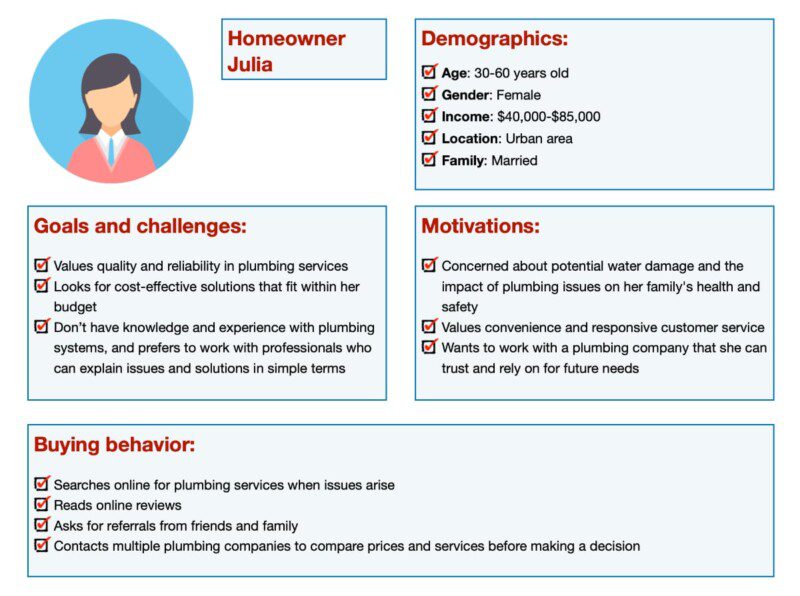
Next, you can start analyzing and visualizing your audience’s online journey, or buyer’s journey to better understand behavior flow.
You can visualize this journey by creating the processes your audience usually follows to find information for their problems online. Also, look at your sales process to find what you are doing and what customers are doing from the other side.
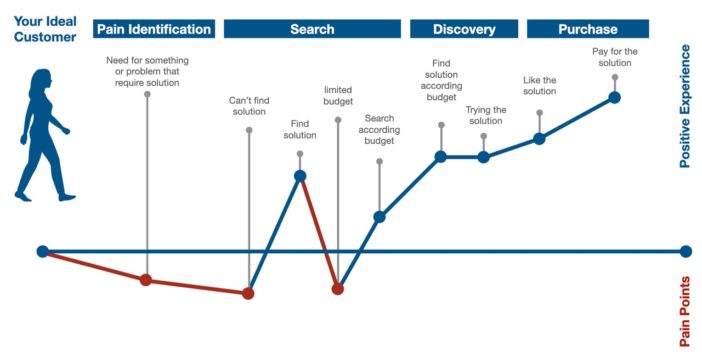
After you visualize the journey, you can respond to the following questions:
- Where are they, or what digital platforms and channels they use?
- How much time do they spend on each platform?
- What do they need from you, or what problems do they have?
- How do they search for solutions? What keywords do they use?
- How can your content help them solve their problems?
- What are their preferred content types and formats? Are they blog posts or short videos?
- What content pieces will they share with others?
As you can see, answering these questions will help you build the foundation for the next steps in creating a content marketing strategy.
Here is an example of defining an audience for content strategy:
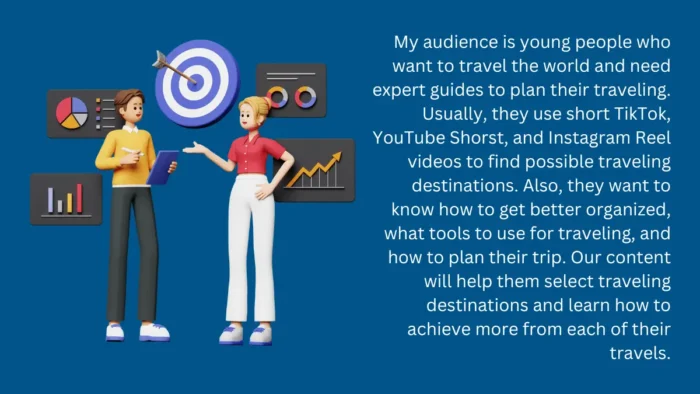
Step 2: Define Your Content Marketing Mission Statement
Once you have a clear understanding of your target audience, you should develop your content marketing mission statement.
This statement will guide all your future content creation efforts and help you stay focused on achieving your overall goals.
To write a clear and effective mission statement, make sure it includes:
- Audience you want to target
- Type of content you will create
- Benefits you will provide to your audience
- Desired outcome or action you want your audience to take after consuming your content.
Here is an example of a clear and effective content marketing mission statement:
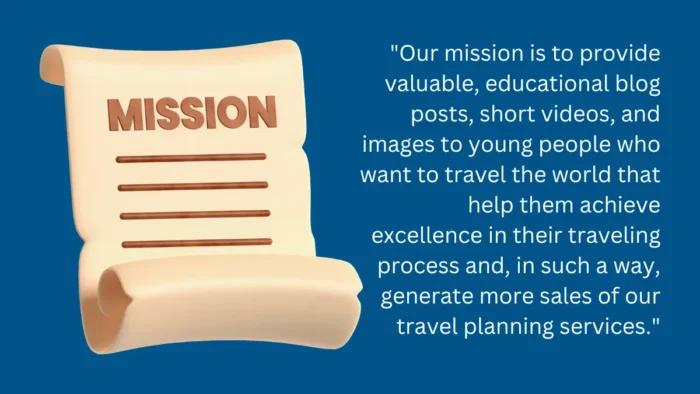
Step 3: Define Your Content Objectives
I know that you have business goals. But why are you doing content marketing?
Each content marketing effort requires a specific goal that can be measured for success. At this point in your strategy, you must define the content marketing objectives used to help you achieve your overall business goals.
So, first, try to translate your business goals into content goals or how achieving content goals will help you achieve your business goals.
Remember that when you set content-related goals, you must ensure they are SMART (Specific, Measurable, Achievable, realistic, and Timely).
Let’s look at some examples of content goals and KPIs that can give you ideas for your own:
Brand Awareness
Example: Next year, we want to:
- increase the number of visitors to our blog posts by 30%,
- achieve more followers on social media accounts by 40%, and
- increase social media engagement by 30%.
Our content team must record and publish weekly podcast interviews with the experts, three engaging how-to blog posts each week on our blog, and share daily short video content and images with quotes from interviews.
KPIs:
- Overall website organic traffic,
- % of website traffic to new posts and podcast interview pages,
- number of followers on Facebook Page, X, LinkedIn, Instagram, YouTube, and TalkTalk, and
- engagements (share, like, comment, and views) on the same channels.
Lead generation
ExampleExample: In the next six months, we want to generate 200 new leads through our newsletter that subscribe from our new blog posts’ subscription form and use a lead magnet—our new ebook, “How to Get Specific Things Done.”
After subscription and confirmation on our email marketing platform, the new lead will get a series of five emails every three days to help them decide to purchase our products and services.
KPIs:
- New subscribers,
- number of ebook downloads,
- email open rates,
- CTR,
- the number of purchases.
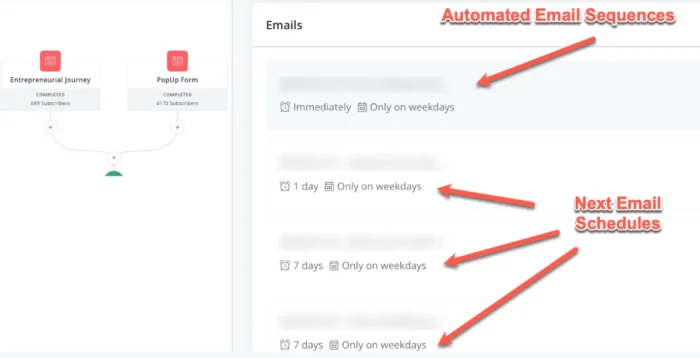
Drive more website traffic by ranking higher in search engine results pages (SERP)
Example: In the next six months, we want to rank on the first page of SERPs for our main keywords related to our products and services by publishing 10 “how-to” articles per month around those keywords.
KPIs:
- position of search results for targeted keywords
- number of links to published articles
Related: 100+ Blog Post Ideas for Your Small Business Blog
As you can see from these examples, if you want to increase your leads by 20%, you must ask yourself how that translates to your blog posts, email campaigns, social media content, or videos.
Step 4: Competitive Research
After you define your target audience and set objectives you want to achieve with your content in the next period of time, it is the right time to start some research. And what better way to start your research than with competitor research?
You want to find out the following:
- What are they doing regarding online content?
- What are their results?
- What topics are they covering?
- How do they engage with other people online?
- What keywords are they targeting for search results?
Keyword Research
For example, let’s say that you are a travel planning services business.
So, the first thing you can research will be related to “travel planning” as a main keyword for organic search.
In this case, I will use Ubersuggest, but you can also use other tools on the market, such as SEMRush or Ahrefs, Google Trends, or the Google Keyword Planner Tool.
The first thing I will do is search for keyword ideas related to travel planning. As you can see, you can filter different keywords using search volume, SEO difficulty, CPC, or specific keywords.
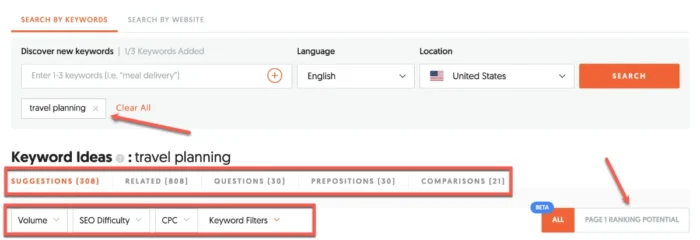
Then, you will get a list of related keyword ideas from the organic search for the main keyword, where you can look for search volume and SEO difficulty.
As you can see, there are over 6,000 monthly searches for “travel planning Google Maps” with medium SEO difficulty. Or “travel plan format,” which is similar to “travel planning itinerary template” but with less competition.
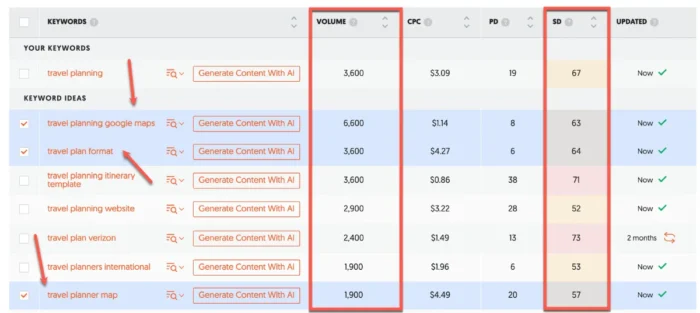
As you can see only from this part of the screen, I already have two interesting content ideas:
- How to Use Google Maps for Travel Planning?
- Travel Plan Format Templates
Also, I can look at the related keywords, questions, prepositions, or comparisons.
As you can see from the screenshot below from questions, there are additional content ideas that will respond directly to the search intent of potential clients:
- How much does a travel planner cost?
- What is the best travel planning app?
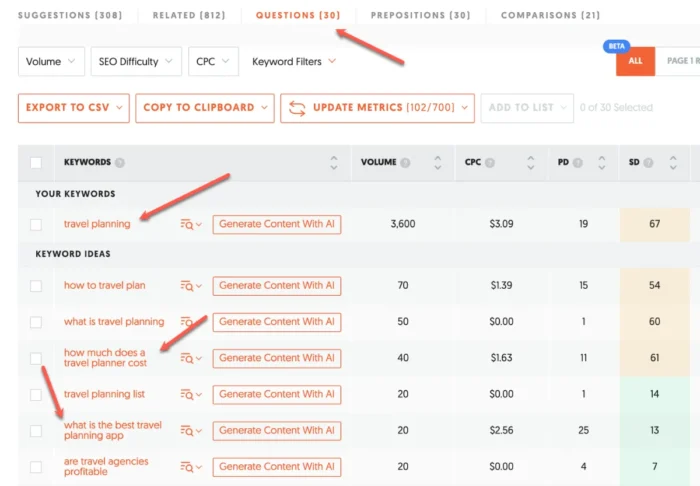
If I check the comparison tab, I can define additional ideas.
For example, there is an interesting keyword related to AI that still has low competition, or there is interest in templates for Google Sheets, Microsoft Excel, or Notion. Also, a really important search keyword related to “travel planning services” shows customers’ potential purchase intent.
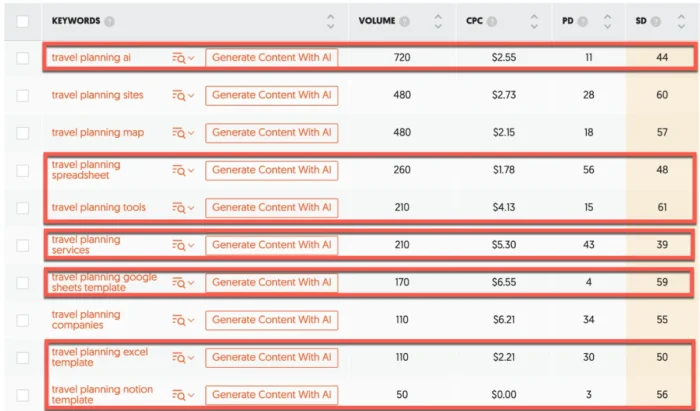
So, from here, we will have additional blog post topics like:
- How to Create a Google Sheets Travel Planning Template?
- How to Create a Microsoft Excel Travel Planning Template?
- How Travel Planning Services Can Make Your Life Easier?
So, you understand why this step of your content strategy is important.
Competition Research
When you select the main and secondary keywords, you can conduct competitor research.
Again, I will use Ubersuggest to analyze the competition. First, you can see the competition for each selected keyword.
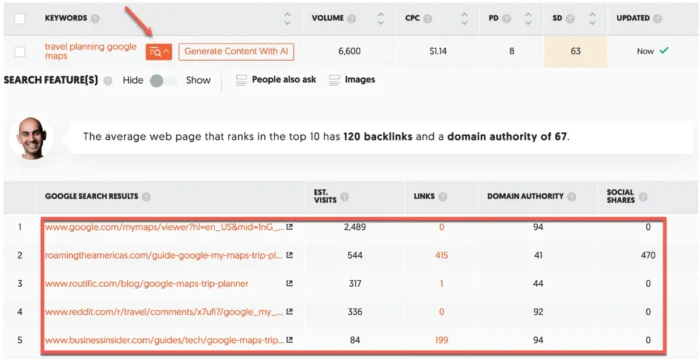
When you click the appropriate competitor, you will get analyzed information about each competitor, such as organic keywords, top pages, social sharing, etc.
Analyzing the competition in this way will help you identify them, learn what they are doing, and find possible content ideas.
But don’t stop here. You can complement this analysis with social listening, content gap analysis, and good, old-fashioned brainstorming sessions. At the same time, internal feedback and data can reveal those “a-ha” for topics that speak to your audience directly.
When you’ve done this, you can start writing your content strategy.
Usually, I suggest using Excel or Google Sheets, but you can simply use Word documents. Now, you can start connecting your goals with keywords and content.
If you want to create your own content marketing strategy quickly, you can download the Excel template here.
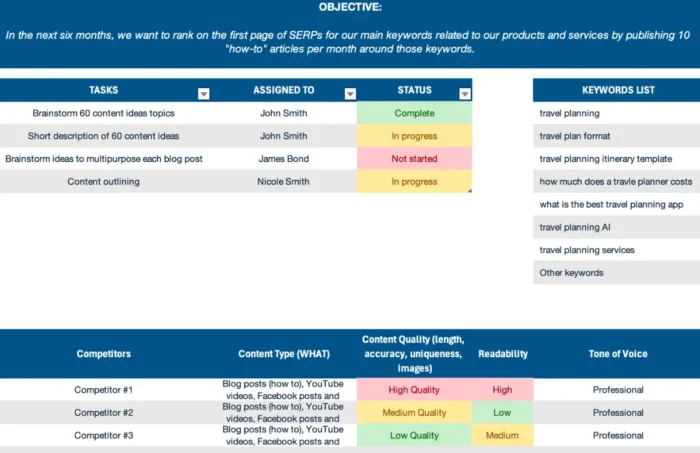
Step 5: Content Types and Ideation
Now, you know who to target with your content and have already learned about competitors, topics, and keywords they are using.
At this step, you must decide on the type of content for each customer segment and distribution platform. According to a Content Marketing Institute, 94% of B2B marketers use short articles/posts as their top choice, with videos (84%) and case studies/customer stories (78%) following closely.
This data underlines the favored content types among B2B marketers, and you must try and test for yourself different formats to see what brings the best possible results for your company.
What type of content formats will you produce?
Now, when you collect everything in one place and pull everything from your head that you think can be beneficial content for your current and potential customers, you can start with building structure around that.
For example, you might have these different content formats inside your content strategy something like this:
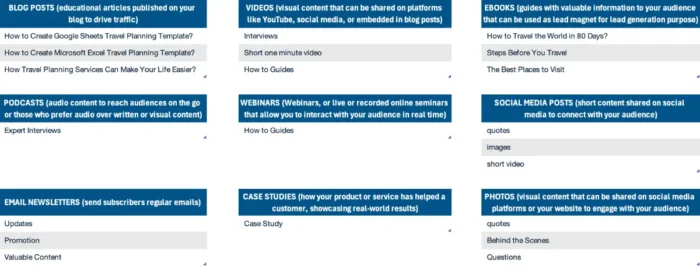
This is not the full list of possibilities for content formats; it’s only a fraction of what you can have as content types.
Ideas for Each Content Type
For each content type, you can generate ideas that respond to audience interest and intent.
Let’s take an example of how you can brainstorm and create content:
- Educational blog posts like “How-to” or instructional articles related to your product or service can be published on your blog and then made a presentation that can be published on Slideshare or video for YouTube.
- Lists like “Top 10 Tips for Travel Planning” or “7 Destinations You Must Visit in 2024” can easily be transformed into images for social media posts or short videos explaining.
- Product reviews of your own products or services or reviews of related products from other brands in your industry as a blog post. Also, you can record your review process and share videos on YouTube or social media.
- News or industry insights where you will write about current events or news related to your industry or brand, discussing trends, challenges, or updates.
- Expert interviews with leaders or experts in your industry for podcasts and videos.
- Behind-the-scenes content to show the human side of your brand and connect with your audience through short videos for YouTube Shorts, TikTok, Instagram, etc.
Remember that your business must provide different content types to different customer segments. You can’t distribute everything to everyone.
Some content types will work better for some of your customers. If you write to students, for example, you must write content for young people and students.
Because of that, you need to look deeper at your customer segments and decide what type of content will be distributed to what types of customers.
Create multi-purpose content
If you want to create high-quality content, you must avoid the one-dimensional approach.
A simple and highly productive content strategy is to create multi-purpose content, which can be repurposed according to reader sentiments, online trends, and customer preferences.
Remember that if you experience writer’s block, there are some strategies that will help you beat your writer’s block.
For instance, consider a write-up that can be restructured as a podcast topic, support article, conference talk, or simple guest post, as necessary.
Develop more audio and visual content.
The two most popular forms of content marketing online are audio and visual presentations and long-form written content. Still, for the last several years, video has dominated, especially among younger people.
Video content is a great way to build content for online platforms like TikTok or YouTube, where the video is the only commonly shared content.
Quality, not quantity, is what matters the most.
Value addition is the key to content marketing success. Therefore, to make the post resonate better, try to target a topic that would be useful to the audience.
If you find a topic and its associated ideas difficult to communicate to the public, they are likely to be actionable and resourceful in nature.
Step 6: Content Creation

The step of creating content, or the content production process, in your content strategy, must clearly define how the content will be created, who will create it, and when it will need to be created.
Editorial Calendar
One of the best ways to document the how, who, and when of creating content is to use an editorial calendar tool.
This tool that highlights a strategic view of the type of content will be created and shared and will allow you to:
- plan and organize your content creation process,
- stay consistent with publishing frequency, and
- later, assign tasks and deadlines for team members and track progress inside your content calendar.
Here is one possible content calendar you can use. As you can see, you will need to consider the publishing schedule for each post type and channel.
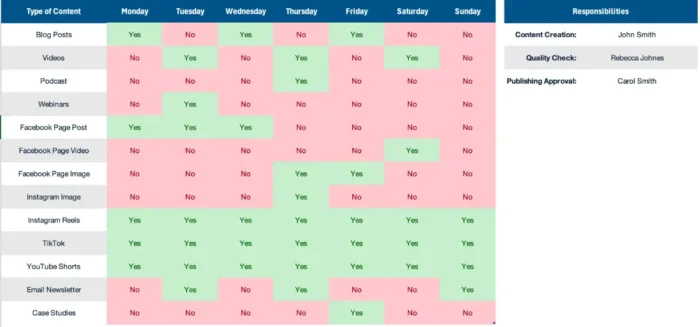
So, here we don’t go into details but only create a schedule of what will need to be published, where, and on which day. Also, at this stage, we must think about responsibilities, and the four most important are:
- Who will create the content?
- Who will check content quality?
- Who will approve publishing?
- Will we use and how will we use user-generated content?
So, now, with this editorial calendar, you and your team members can quickly organize your publishing schedule inside your content calendar.
Content Calendar
A content calendar is more tactical than strategic because it is focused on the micro level, where your business creates content and tracks progress.
Here is a possible way to organize your content calendar:
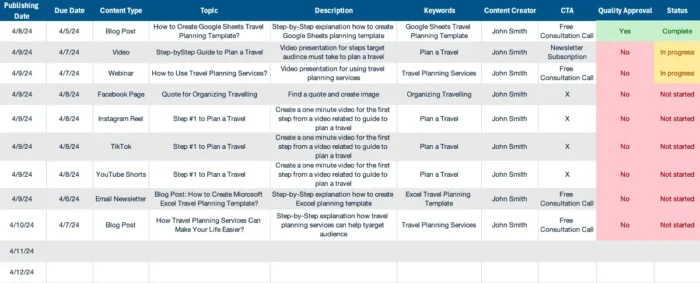
Quality Approach
Your content marketing strategy also must explain how your company will ensure that each piece of content is of sufficient quality to be categorized as valuable, readable, or shareable.
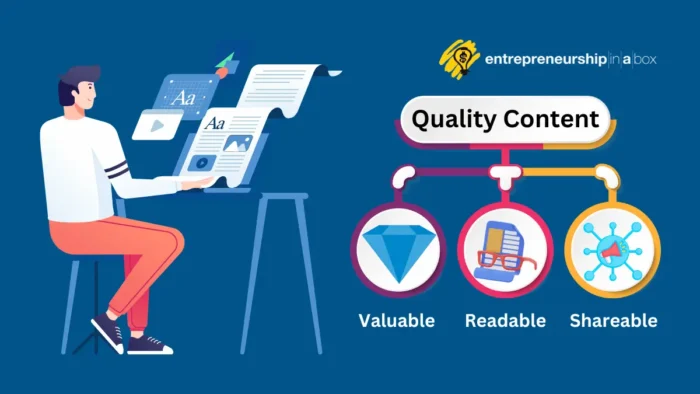
So, you must respond to the following question:
- What will be considered as quality content for each content type?
- Who will be responsible for quality checks?
- Who will be responsible for content approval for publishing or sharing?
Additionally, don’t be afraid to update and revise old blog posts as needed.
For example, this blog post you are reading now is also updated, expanded, and grouped by posts written even 14 years ago.
Consider your marketing content to be a continuous work-in-progress and resist the temptation to get complacent in your work.
Step 7: Content Distribution
You have the product and content, and now you need to distribute it to the people who really need it.
Your content marketing strategy also must include a detailed description of distributing content, or each channel and each type of content that will be distributed through that channel.
Do you have an amazing blog post or web page that doesn’t get near the amount of traffic you think it deserves?
Most companies do, and it’s a shame. That’s because a great piece of content can go to waste if you don’t properly promote it.
Back your work up by sharing it across social media platforms.
Remember that your content must be where your audience is, whether that’s LinkedIn, a niche industry forum, or the feeds of an Instagram celebrity your persona adores.
The choice of channels is strategic, never arbitrary. Each channel implicates a different audience mindset and, consequently, format.
Step 8: Measure Your Success
At this point, you have content and are using different channels to promote it. So, the question is, how do you know it’s working?
Key Performance Indicators (KPIs) are content marketing metrics you will use to check your achievements with your content marketing strategy.
KPIs will show you the engagement level, conversion rates, the success of your call to action (CTA) on landing pages, etc.
For each channel, you have free tools to collect data. For example, you can use Google Analytics to measure the number of visitors or clicks on CTAs. Or you can use Google Search Console to find the performance of your content on Google.
Additionally, you can use platform-specific insights, like Facebook or Instagram Insights, to measure social media followers or engagement rates. Each offers a different part of the content experience.
Figuring out which pieces of existing content generate phone calls to your sales staff is one of the fastest ways to identify successful (and not-so-successful) strategies.
From there, you can alter new content to more accurately align with what your customers desire.
Step 9: Continuous Improvement
Remember that your content strategy is not a static document.
I have seen many entrepreneurs and managers look at strategic documents, not only content marketing strategy, but also at other strategies, like a document that can not be changed until it is not totally implemented.
This is a really wrong approach, especially today when we can not predict what will happen in the next year.
So, your content marketing strategies must continuously evolve with your audience and objectives.
So, you must dedicate time to understanding the what and why behind your KPIs.
The best way to ensure a continuous improvement process to your existing content is to periodically use a content audit.
A content audit is a method of tracking, analyzing, and assessing all the content your company has published. It should be part of every content marketing strategy, as it can provide valuable insights that will help improve future content.

Content audit answers critical questions such as:
- What content do we have on our site and across our platforms?
- How is each piece of content performing regarding engagement, traffic, and conversions?
- What are the gaps in our content strategy, and where are the opportunities for improvement?
- Is existing content outdated or no longer relevant to our audience?
- What are the patterns or trends in the content that perform well?
- Where is our content against competition?
- Are there any content redundancies, and can content be consolidated for better impact?
Remember, every piece of content offers lessons worth learning and implementing.
Sometimes, common writing mistakes are unavoidable. After all, we still rely on humans to write pieces.
Yes, I know that you have the possibility to create content with the help of AI but believe me, I have had a bad experience because I agreed to publish content by other people that are 100% AI-written.
Conclusion
As you can see, content is a vital part of a company’s online presence.
Creating and organizing excellent content for your company will improve your advertising efforts and reduce expenses.
Developing a content marketing strategy is a blend of art and science.
Now, you have enough knowledge to start preparing your content marketing strategy. Start assembling it today!
You will have many tweaks until everything becomes perfect. It’s important to start with something and improve the whole process as you go.
In the end, you will ask, what’s next? You have your content marketing strategy, and now is the right time to create processes that will be followed. Also, ensure you will have documented content marketing examples for each format so your team members can replicate the success of your best content.

